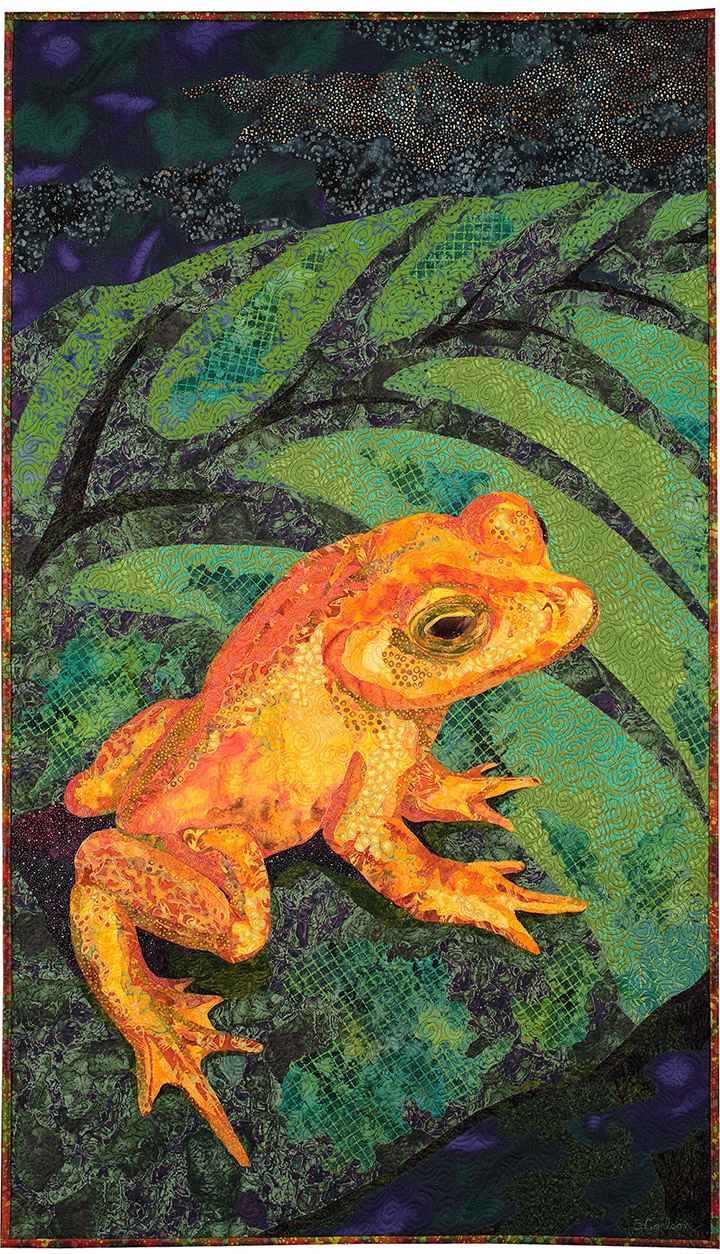
Growing up in suburban Maryland, I was somewhat removed from the natural cycle of the world. Getting away from the street lights and into nature meant weekend-long, rain-soaked camping trips with the Girl Scouts. Then I moved to rural Maine.
In Maine there are the self-evident markers of the seasons—leaves turning golden and scarlet, the first snowfall, the pale blush of new green leaves. Then there are cyclical signs that I had no idea existed. One of the most anticipated is the awakening of the peepers in the early spring.
What are peepers? Peepers are tree frogs. They’re no bigger than your thumbnail, but when they gather around vernal pools, marshes, and other wetlands in the spring to mate and lay their eggs, their collective songs can be deafening. On a mild evening driving down the road with the windows open you can hear them at each wet place along the road. Below is a recording of peepers in our field.
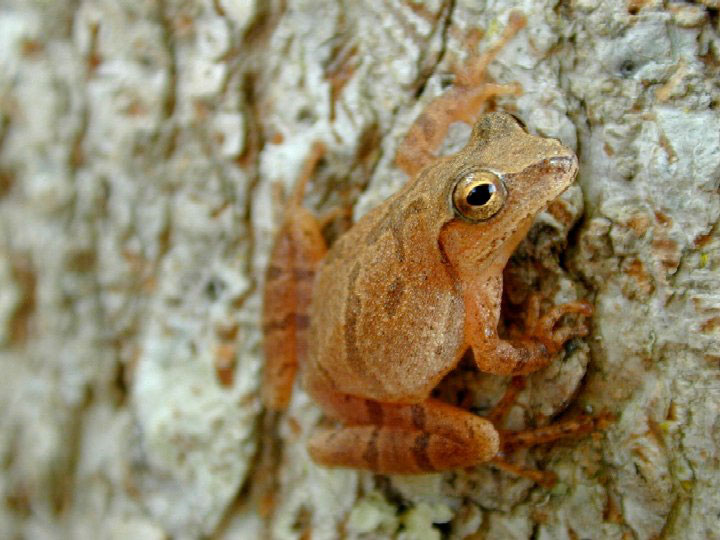
Peepers in Harpswell
Audio Player
Peepers have become a part of my life. I mark the first peepers on my calendar as my own unofficial first day of spring. My attachment to these tiny amphibians is the best explanation why I chose to create “Million to One.”
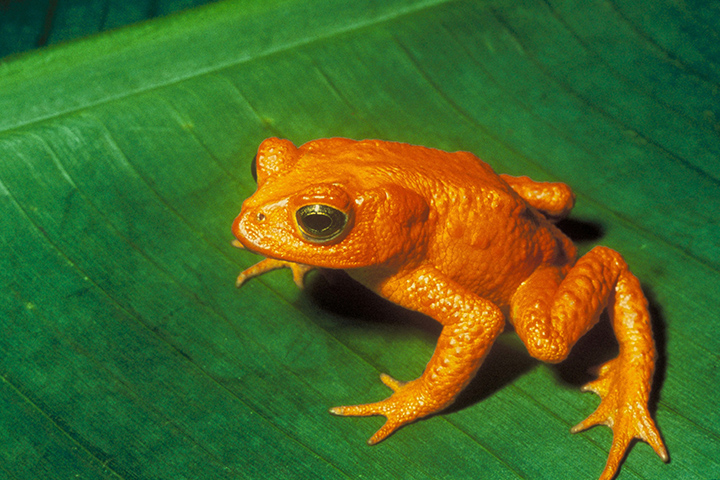
The Golden Toad
I first heard about the Costa Rican Golden Toad years after it had gone extinct, in 2005 I believe. A radio news program reported a poignant story about the toad’s swift extinction in the late 1980s. According to the report they lived only in a small 10 kilometer-square patch of forest in Costa Rica’s Monteverde Cloud Forest Reserve. The toads were discovered in 1964 and were abundant as recently as 1987. The last male was seen in 1989.
Now, scientists still ponder and debate the cause of their rapid decline but agree that unusually warm conditions due to El Nino weather patterns, climate change, a fungal infection brought on by the dryness, or all of the above, could have made breeding conditions impossible.
But it was the story, the image, of that last male, the one seen in 1989, that really caught me.
Like our own peepers here in Maine, the golden toad was known for its raucous peeping, making it more often heard than seen. A poignant anecdote recalls hearing what was presumed to be this last toad peeping, peeping—a solitary voice where years before his kindred sang by the thousands.
Of course he didn’t know he was the last of his species. He was just a little toad after all. But even in his tiny amphibian brain there must have been some inkling, some spark between neurons that said, “Somethin’ here just ain’t right.”
Million to One
I knew right away after listening to the radio program that the golden toad needed to be in my collection of “Specimens” quilts. I was touched by the story and I thought maybe my work could turn around and touch someone else in a visual rather than audio way. The idea of making a quilt of the toad made me think more about the statement I could make with my work. Instead of just creating interesting colorful animals, could they go beyond novelty and talk about the story behind these animals?
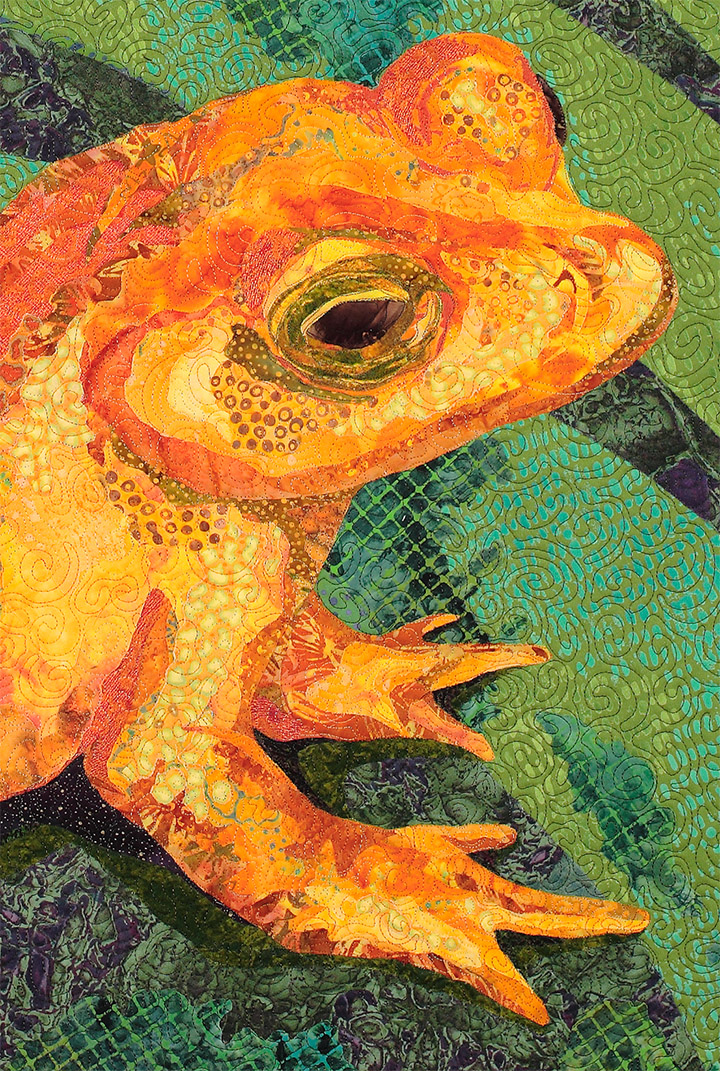
I researched what the toad looked like and discovered that it was tiny. I knew then that scale was going to be important. Many of my “Specimens” quilts are life-size—the 20-foot long croc, the actual-size dixie dingo—but of course the golden toad had to be larger than life-size. Rather than sweat it too much, I used my drawing/piecing table as a guide. I made it as big as I could fit on my table.
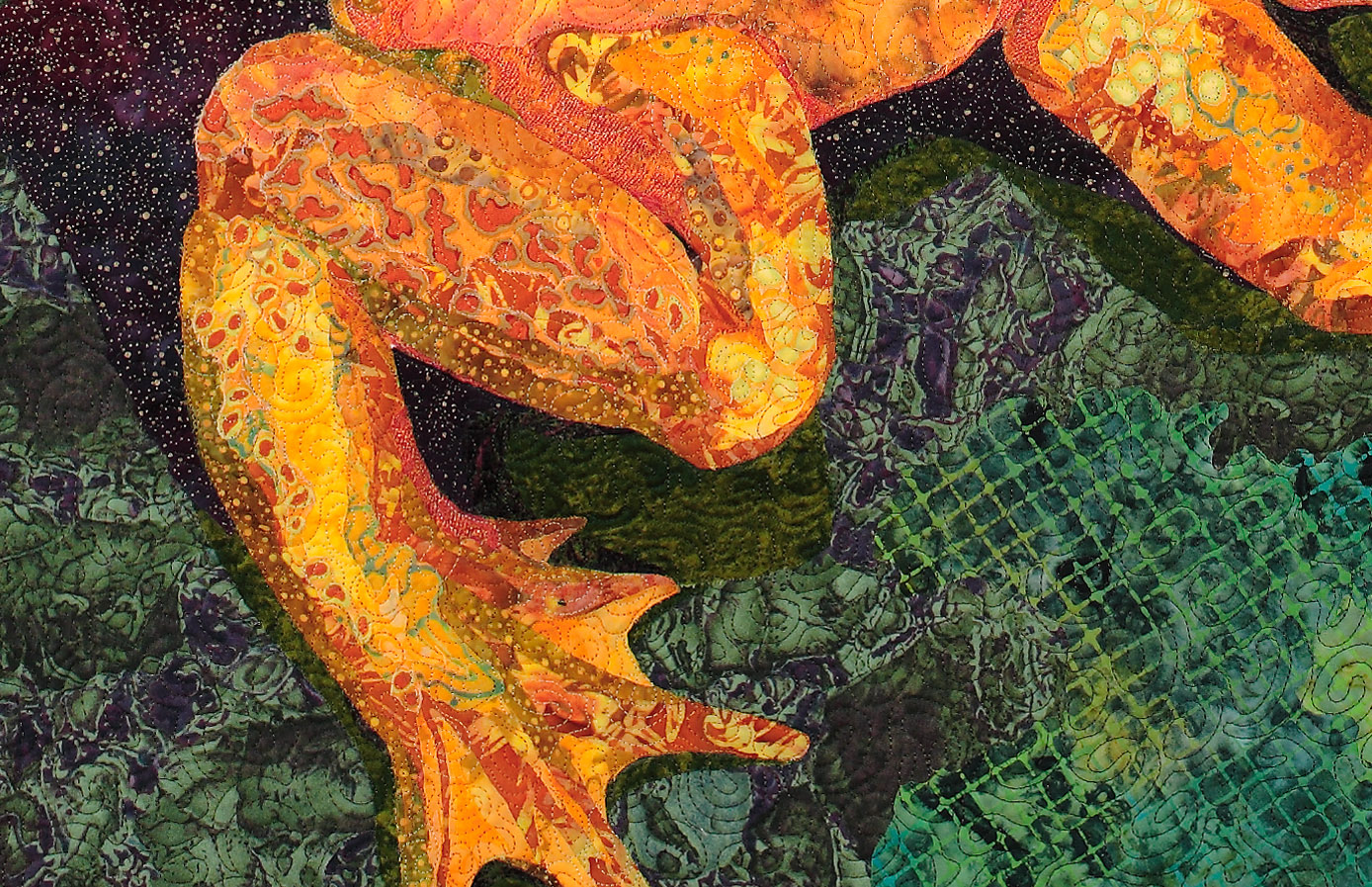
As I was making the piece, I was imagining it as a portrait of that last toad, the last of his species. Making him large emphasizes how important he was, how unique. He truly was a “specimen”—a unique example of his species.
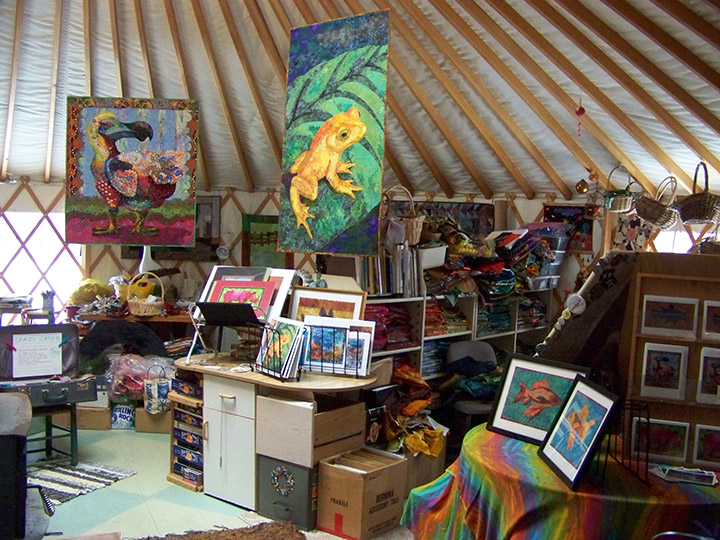
Jeepers, Peepers
Some years we hear fewer peepers, some years more, but overall they seem to be in decline. It may be that the wet areas nearby are drying up naturally and peepers are doing fine elsewhere. Or it may be part of a larger trend. They still seem pretty numerous, but what a loss it would be if 20 or 30 years down the road someone living here wouldn’t hear the peepers.
Extinction is forever. It is also inevitable: 99.99 percent of all species that ever existed are extinct. I wonder when that day will be for our own peepers here in Maine. Since amphibians are the canaries in the coal mine for pollution and climate change, I suspect it will happen long before we humans shuffle off.

I love the spring peepers too! I record them and send the recording to my grownup boys who no longer live here, so that they know that it’s Spring back home! (Both of them are biologists)
I love the spring peepers too! I record them and send the recording to my grownup boys who no longer live here, so that they know that it’s Spring back home! (Both of them are biologists)
Beautifully written, Susan. Creating something captivating that also has a story will reach folks in a different and meaningful way. The size of your toad reminds me of something Georgia O’Keeffe said about her larger than life flowers……she made them large so people would stop and look and see what they had been missing.
Beautifully written, Susan. Creating something captivating that also has a story will reach folks in a different and meaningful way. The size of your toad reminds me of something Georgia O’Keeffe said about her larger than life flowers……she made them large so people would stop and look and see what they had been missing.
This quilt and your narrative deeply touched my heart. I too grew up in the Girl Scouts with nature as my sanctuary, I too had the gift of living in Maine (Wells) for 5 years, and the music of the Spring Peepers is my most favorite noise. Thank you for your words, inspiration and vision.
This quilt and your narrative deeply touched my heart. I too grew up in the Girl Scouts with nature as my sanctuary, I too had the gift of living in Maine (Wells) for 5 years, and the music of the Spring Peepers is my most favorite noise. Thank you for your words, inspiration and vision.
As I read your piece today, I realized what it is that has drawn me to your work. Yes, you are an extraordinary visionary who expresses herself with quilts. The real draw is the story behind it. I love your stories. I have always told my customers the story behind the yarn I created or the weaving, or the knitted piece. I think it is important to understand the “story” behind a creation. By-the-way, two weeks ago NPR interviewed some scientists that have been working for years on preventing extinction of some species of frogs and toads. Some have gone-such as your golden toad-but some are hanging in there. I was touched that they found a species in the Sierra Nevada Mtns that can only live in this one lake. That lake is at a very remote high altitude, and it does not have any fish. These scientists worked for ten years with the game and fish people to remove all fish that had been introduced and to create the proper habitat. They took the few little frogs from the artificial lab in individual Tupperware containers by backpack. They allowed the fish and game people that had worked to help release them. They have been back once to check on them, and they are thriving so far. I agree they are the canary in the coal mine.
As I read your piece today, I realized what it is that has drawn me to your work. Yes, you are an extraordinary visionary who expresses herself with quilts. The real draw is the story behind it. I love your stories. I have always told my customers the story behind the yarn I created or the weaving, or the knitted piece. I think it is important to understand the “story” behind a creation. By-the-way, two weeks ago NPR interviewed some scientists that have been working for years on preventing extinction of some species of frogs and toads. Some have gone-such as your golden toad-but some are hanging in there. I was touched that they found a species in the Sierra Nevada Mtns that can only live in this one lake. That lake is at a very remote high altitude, and it does not have any fish. These scientists worked for ten years with the game and fish people to remove all fish that had been introduced and to create the proper habitat. They took the few little frogs from the artificial lab in individual Tupperware containers by backpack. They allowed the fish and game people that had worked to help release them. They have been back once to check on them, and they are thriving so far. I agree they are the canary in the coal mine.
What a coincidence. Yesterday when I was cleaning up and sweeping off my deck, I discovered I had a little toad/frog. He is bigger than yours — would fit in the palm of my hand, and not nearly as handsome wearing a basic dark green/black suit. I knew I had one in a flower pot by my front door on the opposite side of the house (he let himself be known, loudly) but I didn’t realize there were relatives in the neighborhood. He/they/it join a lengthening list of wildlife that call my yard “home”.
What a coincidence. Yesterday when I was cleaning up and sweeping off my deck, I discovered I had a little toad/frog. He is bigger than yours — would fit in the palm of my hand, and not nearly as handsome wearing a basic dark green/black suit. I knew I had one in a flower pot by my front door on the opposite side of the house (he let himself be known, loudly) but I didn’t realize there were relatives in the neighborhood. He/they/it join a lengthening list of wildlife that call my yard “home”.
I love and admire the works of learned a lot from reading older workflows thank you for sharing my work I hope you manage to utilize a pity that I do not speak anyelvet to better understand processes using colors still having trouble .köszönet at every scale from which I can learn to love happy sewing Marika
I love and admire the works of learned a lot from reading older workflows thank you for sharing my work I hope you manage to utilize a pity that I do not speak anyelvet to better understand processes using colors still having trouble .köszönet at every scale from which I can learn to love happy sewing Marika
I am so enjoying your post on older works. It tells me much about you and what is in your place. Thank you.
I am so enjoying your post on older works. It tells me much about you and what is in your place. Thank you.
Here I am, years later, I just read the little peeper’s story and I have tears in my eyes.